
Best Website for Herkimer Diamond Information
Last Updated:

About this Webpage:


Free Website Where Herkimer Diamond Enthusiasts Share Information with the Public
Scroll down
Dr.C. did two talks at the Herkimer Diamond Festival (July)which are in a Youtube movie. The research on the Herkimer District is in need of samples and photos.
How can you help? Visit the "how to help" page.

Calcite is the third most common mineral (after dolomite and quartz) in the Herkimer district. Calcite is a late event in the district, happening after the Herkimer diamonds formed and sometimes encapsualting them.
There are three calcite episodes, or phases. Calcite displays a variety of shapes across the district. Photos and descriptions of these three calcite phases are shown below.



Phase 1 calcite
W. David Hoisington, Ph.D.

Phase 2 calcite


Phase 3 calcite

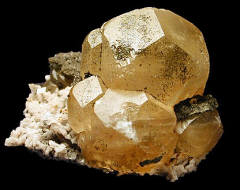
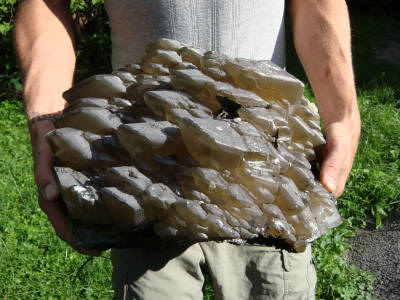
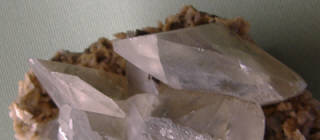
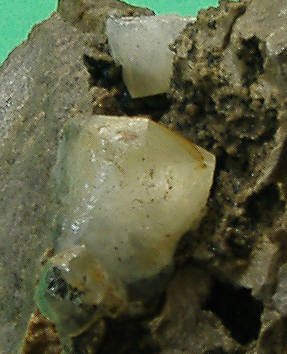
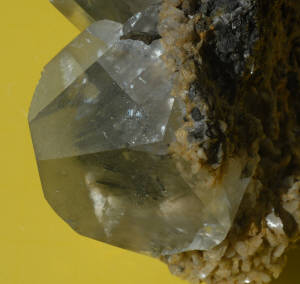
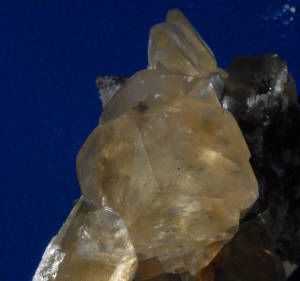
Photo 1
Photo 2
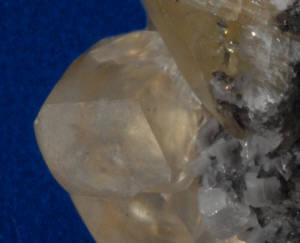
Photo 3
Photo 4
Photo 5
Photo 6
Photo 7
A collection of quality calcite, all from HBQ (St. Johnsville) except photo 6, which is from AD (Middleville). The photos were selected to show the crystal form that, were it not so weathered in other locations, would likely be more present throughout the district. The most common shape that calcite takes within the Herkimer district is what is called "nailhead" - the three pyramid faces (meet at the blue arrow) are shaped like the head of an old hand forged nail. The first four photos (and the NYSM photo at the top of the page) attempt to show this common form.
Photo 1: The characteristic three face top is shown with the junction of the three faces at the arrow. The specimen was donated by Mike Eggleston, 2008. The crystal at the top is 4.5 cm from tip-to-tip. Photo Dr.C. 2008.
Photo 2: Another crystal showing the three face termination. Purchased 2008, photo Dr.C. 2011.
Photo 3: Another crystal showing the three face termination. Purchased 2008, photo Dr.C. 2011.
Photo 4: This grey translucent calcite is not common, but the crystal at the top shows well developed faces, which can be hard to find because most calcite in the district is etched. Think of the view as looking at the side of the "nail's head". I think, with a little imagination, the "head of a nail" can be seen. The meeting of the three faces is at the arrow. The specimen was donated by Mike Eggleston, 2008. The crystal at the top is 4.5 cm from tip-to-tip. Photo Dr.C. 2008.
Photo 5: Photo sent by Frank, 2010, that shows a large group (quite uncommon) of calcite. What is common are the rounded edges of the crystals, and their parallel growth.
Photo 6: It is not unusual for the naihead habit to occur in parallel growth. This specimen is from Frank's collection. The line at the top is marcasite and there is white dolomite at the base. Photo by Frank, 2010.
Photo 7: The white arrows again points to the nailhead termination tip. In this specimen the crystal is stretched quite a bit between the two terminations resulting in a long prismatic shape (some call them "barrel shaped"). This form appears to be rare for the district. Specimen is 4 cm top-to-bottom, donated by Bill and Anne. Photo Dr. C., 2008
More calcite photos can be found on the individual mine web pages which can be accessed by clicking on Directions at the top of this page.
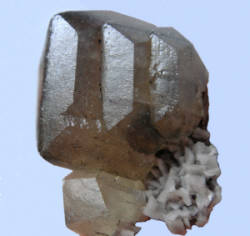
Phase 2 calcite is difficult to find, as it seems it was not a strong event in the Herkimer district. In addition the crystals are usually very small. But their habit is quite different than first phase calcite.
Photo 1: Here you can see the pyramid terminations of the phase one calcite and the usual disc shpaed crystals. The crystal is coated white, with second phase calcite. Specimen from St. Johnsville, donated by Frank, 2011.
Photo 2: The next photo is quite interesting. At first appearances it looks like some strange form of dolomite. But it is actually a form of phase two calcite on top of dolomite. It would be easy to pass by this, and probably toss it out while still in the mine. From St. Johnsville, HBQ, donated by Bob. Photo Dr.C., 2008 - 2 cm across the photo.
Photo 3: Now combine a stack of disc crystals like in photo 1 and cover then with the calcite in photo 2 and the result is photo three. Thanks to Bill and Anne for donating this photo. Specimen is from the AD in Middleville, NY.
Photos 4 and 5: Phase 2 calcite can also occur as honey, or amber, crystals. These are found as tiny microscopic crystals in Fonda (DA). The two photos are of specimens donated (by "Deputy Mike") in 2008. The specimens cover 1.5 cm in each instance. This form of amber calcite has been found to occur as overgrowths on grey/white calcite (blue arrow) - but such an occurence is extremely rare. The "fan like" form of the these amber crystals can be seen, using a microscpe, in the clear crystals of photo #2.
More research needs to be done on phase 2 calcite, and more specimen donation help.
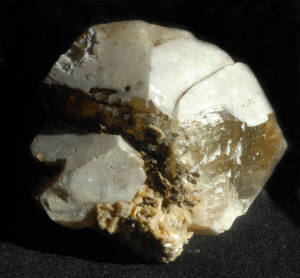
Photo 1
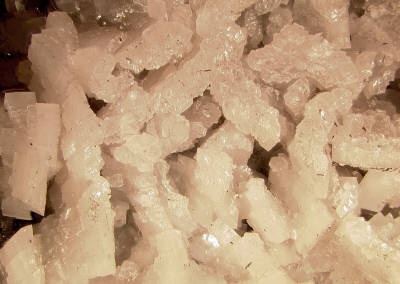
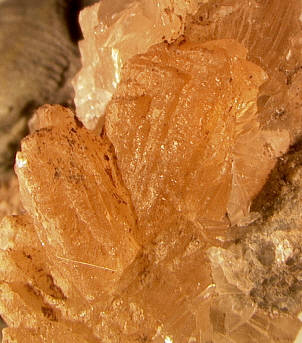
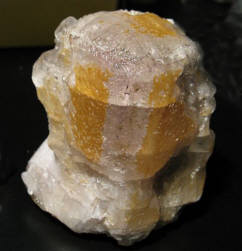
Photo 2
Photo 3
Photo 4
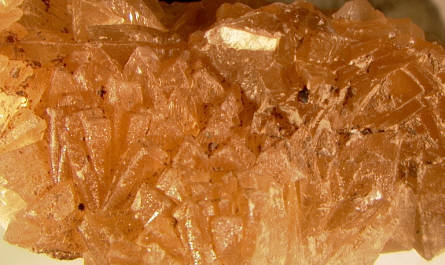
Photo 5
Phase 1 calcite
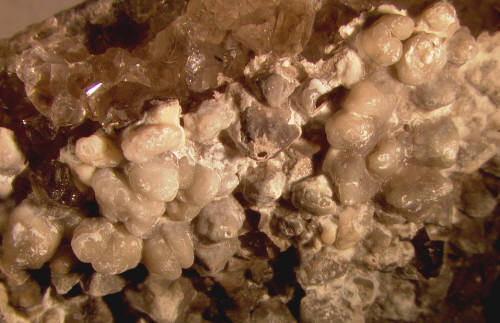
To the right is a photo of 3rd phase calcite collected at the TCR site (2009), with permission from the owner. Again, it occurs as a mounded coating called "boytoyroidal". This specimen photo is 2 cm across. The little bumby mounds are not only hard to find in the field, they are hard to find intact. Even these show significant effects from weathering. But weathered versions of this phase 2 calcite seem to be quite common across the district - except at HBQ. Photos Dr.C., 2010
Similar 3rd phase calcite has been seen at DA, but so severly etched it was not possibe to provide it as photographic evidence.
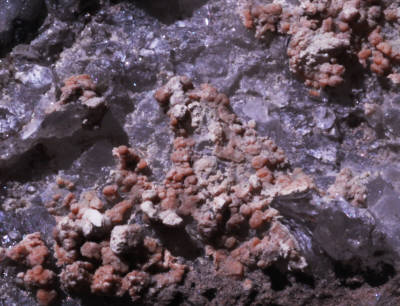


Unusual calcite
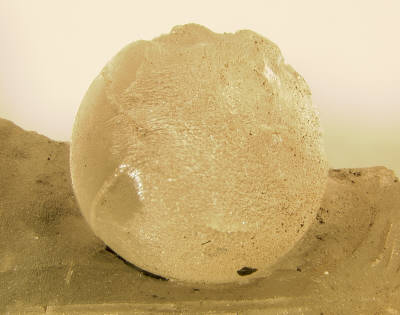
The specimen on the left is from the TCR location and part of the mine owner's collection (2009). It is about 5mm in diameter.
See the quartz sphere page for a theory on how this calcite sphere formed.
July, 2011
